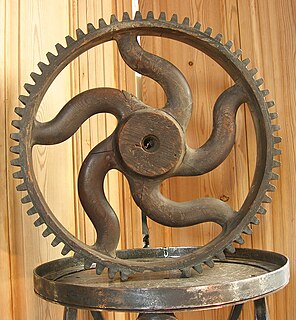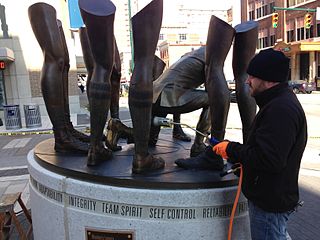
An action figure is a poseable character model figure made most commonly of plastic, and often based upon characters from a film, comic book, military, video game or television program; fictional or historical. These figures are usually marketed toward boys and adult collectors. The term was coined by Hasbro in 1964 to market G.I. Joe to boys.

Plaster is a building material used for the protective or decorative coating of walls and ceilings and for moulding and casting decorative elements. In English, "plaster" usually means a material used for the interiors of buildings, while "render" commonly refers to external applications. Another imprecise term used for the material is stucco, which is also often used for plasterwork that is worked in some way to produce relief decoration, rather than flat surfaces.

Bronze is the most popular metal for cast metal sculptures; a cast bronze sculpture is often called simply "a bronze". It can be used for statues, singly or in groups, reliefs, and small statuettes and figurines, as well as bronze elements to be fitted to other objects such as furniture. It is often gilded to give gilt-bronze or ormolu.

Stone carving is an activity where pieces of rough natural stone are shaped by the controlled removal of stone. Owing to the permanence of the material, stone work has survived which was created during our prehistory or past time.

Papier-mâché is a composite material consisting of paper pieces or pulp, sometimes reinforced with textiles, bound with an adhesive, such as glue, starch, or wallpaper paste.

Stucco or render is a construction material made of aggregates, a binder, and water. Stucco is applied wet and hardens to a very dense solid. It is used as a decorative coating for walls and ceilings, exterior walls, and as a sculptural and artistic material in architecture. Stucco can be applied on construction materials such as metal, expanded metal lath, concrete, cinder block, or clay brick and adobe for decorative and structural purposes.

Lost-wax casting is the process by which a duplicate metal sculpture is cast from an original sculpture. Intricate works can be achieved by this method.
This page describe terms and jargon related to sculpture and sculpting.

Ferrocement or ferro-cement is a system of construction using reinforced mortar or plaster applied over an "armature" of metal mesh, woven, expanded metal, or metal-fibers, and closely spaced thin steel rods such as rebar. The metal commonly used is iron or some type of steel, and the mesh is made with wire with a diameter between 0.5 mm and 1 mm. The cement is typically a very rich mix of sand and cement in a 3:1 ratio; when used for making boards, no gravel is used, so that the material is not concrete.
Ceramic forming techniques are ways of forming ceramics, which are used to make everything from tableware such as teapots to engineering ceramics such as computer parts. Pottery techniques include the potter's wheel, slip casting and many others.
Model animation is a form of stop motion animation designed to merge with live-action footage to create the illusion of a real-world fantasy sequence.

In casting, a pattern is a replica of the object to be cast, used to prepare the cavity into which molten material will be poured during the casting process.

The Victorious Youth, Getty Bronze, also known as Atleta di Fano, or Lisippo di Fano is a Greek bronze sculpture, made between 300 and 100 BC, in the collections of the J. Paul Getty Museum, Pacific Palisades, California. Many underwater bronzes have been discovered along the Aegean and Mediterrean coast; in 1900 sponge divers found the Antikythera Youth and the portrait head of a Stoic, at Antikythera, the standing Poseidon of Cape Artemision in 1926, the Croatian Apoxyomenos in 1996 and various bronzes until 1999. The Victorious Youth was found in the summer of 1964 in the sea off Fano on the Adriatic coast of Italy, snagged in the nets of an Italian fishing trawler. In the summer of 1977, The J. Paul Getty Museum purchased the bronze statue and it remains in the Getty Villa in Malibu, California. Bernard Ashmole, an archaeologist and art historian, was asked to inspect the sculpture by a Munich art dealer Heinz Herzer; he and other scholars attributed it to Lysippos, a prolific sculptor of Classical Greek art. The research and conservation of the Victorious Youth dates from the 1980s to the 1990s, and is based on studies in classical bronzes, and ancient Mediterranean specialists collaboration with the Getty Museum. The entire sculpture was cast in one piece; this casting technique is called the “lost wax” method; the sculpture was first created in clay with support to allow hot air to melt the wax creating a mold for molten bronze to be poured into, making a large bronze Victorious Youth. More recently, scholars have been more concerned with the original social context, such as where the sculpture was made, for what context and who he might be. Multiple interpretations of where the Youth was made and who the Youth is, are expressed in scholarly books by Jiri Frel, Paul Getty Museum curator, from 1973 to 1986, and Carol Mattusch, Professor of Art History at George Mason University specializing in Greek and Roman art with a focus in classical bronzes.
An armature is the name of the kinematic chains used in computer animation to simulate the motions of virtual human or animal characters. In the context of animation, the inverse kinematics of the armature is the most relevant computational algorithm.
Writing material refers to the materials that provide the surfaces on which humans use writing instruments to inscribe writings. The same materials can also be used for symbolic or representational drawings. Building material on which writings or drawings are produced are not included. The gross characterization of writing materials is by the material constituting the writing surface and the number, size, and usage and storage configuration of multiple surfaces into a single object. Writing materials are often paired with specific types of writing instruments. Other important attributes of a writing material are its reusability, its permanence, and its resistance to fraudulent misuse.

Casting is a manufacturing process in which a liquid material is usually poured into a mold, which contains a hollow cavity of the desired shape, and then allowed to solidify. The solidified part is also known as a casting, which is ejected or broken out of the mold to complete the process. Casting materials are usually metals or various time setting materials that cure after mixing two or more components together; examples are epoxy, concrete, plaster and clay. Casting is most often used for making complex shapes that would be otherwise difficult or uneconomical to make by other methods. Heavy equipment like machine tool beds, ships' propellers, etc. can be cast easily in the required size, rather than fabricating by joining several small pieces.

Conservation and restoration of ceramic objects is a process dedicated to the preservation and protection of objects of historical and personal value made from ceramic. Typically this activity of conservation-restoration is undertaken by a conservator-restorer, especially when dealing with an object of cultural heritage. Ceramics are created from a production of coatings of inorganic, nonmetallic materials using heating and cooling to create a glaze. Typically the coatings are permanent and sustainable for utilitarian and decorative purposes. The cleaning, handling, storage, and in general treatment of ceramics is consistent with that of glass because they are made of similar oxygen-rich components, such as silicates. In conservation ceramics are broken down into three groups: unfired clay, earthenware or terracotta, and stoneware and porcelain.
The conservation and restoration of outdoor bronze artworks is an activity dedicated to the preservation, protection, and maintenance of bronze objects and artworks that are on view outside. When applied to cultural heritage this activity is generally undertaken by a conservator-restorer.

The conservation and restoration of outdoor artworks is the activity dedicated to the preservation and protection of artworks that are exhibited or permanently installed outside. These works may be made of wood, stone, ceramic material, plastic, bronze, copper, or any other number of materials and may or may not be painted. When applied to cultural heritage this activity is generally undertaken by a conservator-restorer.














